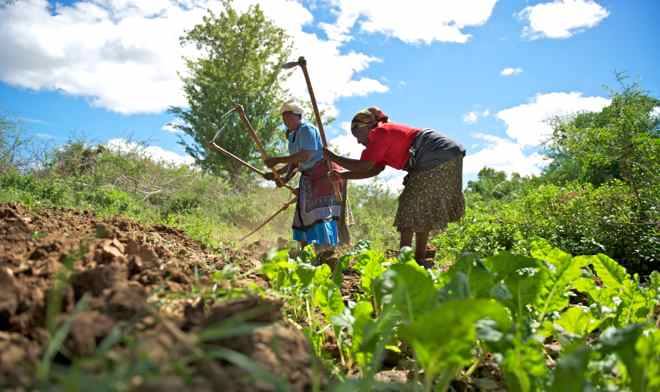 Hilly terrain and heavy rains especially during the long rains have been every farmers’ nightmare as soil erosion continues unabated carrying with it soil nutrients and washing away crops. The situation has been so dire that young people who have decided to try a hand in farming have given up and decided to seek fortunes in the already crowded urban centers.
Hilly terrain and heavy rains especially during the long rains have been every farmers’ nightmare as soil erosion continues unabated carrying with it soil nutrients and washing away crops. The situation has been so dire that young people who have decided to try a hand in farming have given up and decided to seek fortunes in the already crowded urban centers.
Farmers’ reluctance to embrace construction of gabions, trash lines and terraces means that the top soil is always washed away when it rains. 75 year old Irungu Kariuki from Gaitega village in Murang’a County has borne the brunt of soil erosion for the last decade. From low yields to barren land, Kariuki has given up on farming leaving his three acre piece of land at the mercy of the gods.
"With little effort being made in construction of gabions, terraces and even trash lines, most of the top soil continues to disappear during rains. We have witnessed reducing maize production per acre over the recent years", nostalgically, explained the frail Mr. Kauki as he surveys his three acre piece of land overlooking Kaihungu River.
Across Kenya, rivers and streams are often murky-brown and swollen during the heavy rains, an indication of the huge amount of soil being carried away from the shrinking parcels of land. From Kericho, Nandi Hills, Kisii, Narok and the Central Highlands, farmers have witnessed declining production due to the loss of the nutrient rich top soil. Urbanisation and change in land use have also exacerbated the problem- as previously rangelands are opened for farming or real estate development.
"The soil erosion we are experiencing today is new to this area. Grass in these plains ensured ample ground cover which reduced soil erosion. Today, housing development and urban farming has opened up the land for erosion to take effect", said Mr. Kiyoshoni ole Lession, a livestock herder in Kitengela area of Kajiado County. Immigration and settlement has turned parts of Kajiado County previously known for nomadic pastoralism lifestyle to small plots with built up areas where urban agriculture is practiced. In Africa alone, 6.3 million hectares of degraded farmland has lost their fertility and water-holding capacity and need to be regenerated to meet the demand for food of a population set to more than double in the next 40 years, according to the Food and Agriculture Organisation (FAO).
"Soil is an essential component of the world's production systems and ecosystems," says UN Food and Agriculture Organisation (FAO) Director-General Jacques Diouf calling for a renewed international effort to assure sufficient fertile and healthy soils today and for future generation's. Soil is a fragile and non-renewable resource. It is very easily degraded and it is slow, difficult and expensive to regenerate, observed Diouf.
Researchers now pinpoint the grim reaper that is soil erosion and highlight its effects on future land use. A study conducted by Messr: Gachene and others at the University of Nairobi on the effects of soil erosion in high-potential areas of Central Kenya highlands indicate that with annual rainfall ranging between 948 and 1125 mm, soil loss ranged from 0.8 to 247.3 tonnes per hectare. But it is the heavy loss of vital soil nutrients that underscores the damage done on these mountainous soils. According to the study, phosphorus and sodium concentrations were four to 10 times and two to three times higher in eroded soils than the source soil, respectively. These are some of the major nutrients required by plants.
"Sediment from the plots was 247 to 936 richer in phosphorus than the soil from which it originated," the researchers say. Changes in soil pH, percentage organic car-bon and percentage total nitrogen following erosion were significantly similar to the soil loss. It should be noted that most farmers in the country use phosphatic fertilizers such as Diammonium phosphate (DAP) or double super-phosphate (DSP) during planting time. Organic manures such as farmyard and com-post are also used at planting time. At the same time, nitrogenous fertilizers are used in top-dressing crops such as maize when knee-high. With the inherent loss of these soluble nutrients in soil erosion, farmers in the country are losing billions in yields- worsening the already precarious food security situation.
The data from the research indicated that nutrient loss due to erosion is one of the major causes of soil fertility depletion of Kenyan soils. Another research conducted by Eduardo Maeda and others at the Department of Geosciences and Geography in the University of Helsinki, Finland, in 'faita Hill shows that with the expansion of agricultural activities during the last centuries, currently only one per cent of the original vegetation remains. "These landscape changes, together with potential increases in rainfall volumes caused by climate change, offer a great risk for soil conservation", observes the researchers. Consequently, if the current trends persist, agricultural areas will occupy roughly 60 per cent of the study area by 2030. However, rainfall erosivity is likely to increase during April and November, while a slight de-crease tendency is observed during March and May.
















Comments powered by CComment